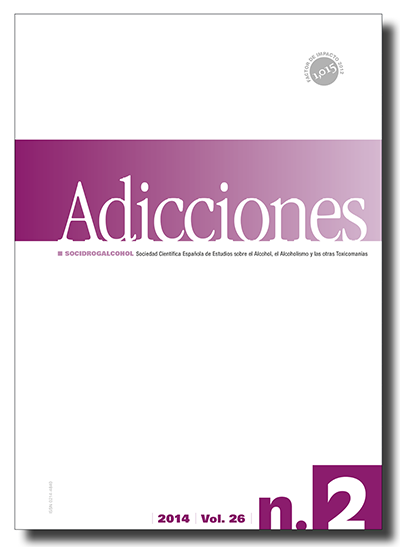Predictors of driving under the influence of alcohol among Spanish adolescents
DOI:
https://doi.org/10.20882/adicciones.11Keywords:
school campaigns, driving, drinking, adolescents, Spain.Abstract
This paper aims to examine the socio-economic determinants of alcohol-impaired drinking in Spanish adolescents. In particular, we are interested in analysing the impact of the family and school environment. To do it, we used the Spanish Survey on Drug Use in the School Population for the year 2008, carried out by the Spanish Government’s Delegation for the National Plan on Drugs. This survey with 30,183 students between 14 and 18 years of age (M = 15.6; SD = 1.17) constitutes a representative sample of the Spanish student population. Of these, 6.7% reported having driven under the influence of alcohol, this behaviour being more frequent among boys (10.6%) than girls (2.9%). Logistic regressions reveal that informative campaigns at school could significantly reduce the likelihood of alcohol-impaired driving (OR = 0.82), especially among males (OR = 0.73) and among younger students (OR = 0.66). Our results also suggest that although parents’ education has no significant impact, parent’s alcohol abuse increase notably the probability of driving after drinking (OR = 2.22 for mothers and OR = 2.81 for fathers).References
Anderson, P., & Baumberg, B. (2006). Alcohol in Europe. London: Institute of Alcohol Studies.
Austin, E. W., & Chen, Y. J. (2003). The relationship of parental reinforcement of media messages to college students’ alcohol-related behaviors. Journal of Health Communication, 8, 157-169. doi:10.1080/10810730305688.
Bina, M., Graziano, F., & Bonino, S. (2006). Risky driving and lifestyles in adolescence. Accident Analysis and Prevention, 38, 472-481. doi: 10.1016/j.aap.2005.11.003.
Brown, S. L., & Rinelli, L. N. (2010). Family structure, family processes, and adolescent smoking and drinking. Journal of Research on Adolescence, 20, 259-273. doi:10.1111/j.1532-7795.2010.00636.x.
Campos, V. R., de Souza e Silva, R., Duailibi, S., Laranjeira, R., Palacios, E. N., Grube, J. W., & Pinsky, I. (2013). Drinking and driving in southeastern brazil: Results from a roadside survey study. Addictive Behaviors, 38, 1442-1447. doi:10.1016/j.addbeh.2012.07.007.
Delegación del Gobierno para el Plan Nacional sobre Drogas (2008). Encuesta Estatal sobre Uso de Drogas en Estudiantes de Enseñanzas Secundarias. Madrid: Author.
Duarte, R., Escario, J. J., & Molina, J. A. (2009). Youth alcohol abuse: Count data estimations. Revista de Economia Aplicada, 17, 81-104.
Elder, R. W., Nichols, J. L., Shults, R. A., Sleet, D. A., Barrios, L. C., & Compton, R. (2005). Effectiveness of school-based programs for reducing drinking and driving and riding with drinking drivers: A systematic review. American Journal of Preventive Medicine, 28, 288-304. doi:10.1016/j.amepre.2005.02.015.
European Monitoring Centre for Drugs and Drug Addiction. (2007). Drugs and driving. Luxembourg: Office for Official Publications of the European Communities.
Finken, L. L., Jacobs, J. E., & Laguna, K. D. (1998). Risky drinking and driving decisions: The role of previou experience. Journal of Youth and Adolescence, 27, 493-511. doi:10.1023/A:1022804219685.
Gullone, E., & Moore, S. (2000). Adolescent risk-taking and the five-factor model of personality. Journal of Adolescence, 23, 393-407. doi:10.1006/jado.2000.0327.
Harré, N., Brandt, T., & Dawe, M. (2000). The development of risky driving in adolescence. Journal of Safety Research, 31, 185-194. doi:http://dx.doi.org/10.1016/S0022-4375(00)00035-9.
Healy, A., Connolly, T. M., & Dickie, A. (2008, October). ThinknDrinkn? - An evaluation of the use of games based learning (GBL) for alcohol awareness. Communication presented at the 2nd European Conference on Games-based Learning, Barcelona.
Hibell, B., Guttormsson, U., Ahlström, S., Balakireva, O., Bjarnason, T., Kokkevi, A., & Kraus, L. (2009). The 2007 ESPAD report-substance use among students in 35 european countries. Stockholm, Sweden: The Swedish Council for Information on Alcohol and Other Drugs.
Hingson, R., Heeren, T., Levenson, S., Jamanka, A., & Voas, R. (2002). Age of drinking onset, driving after drinking, and involvement in alcohol related motor-vehicle crashes. Accident Analysis and Prevention, 34, 85-92. doi:http://dx.doi.org/10.1016/S0001-4575(01)00002-1.
Jack, S. M., Bouck, L. M. S., Beynon, C. E., Ciliska, D. K., & Lewis, M. J. (2005). Marketing a hard-to-swallow message: Recommendations for the design of media campaigns to increase awareness about the risks of binge drinking. Canadian Journal of Public Health, 96, 189-193.
Labrie, J. W., Kenney, S. R., Mirza, T., & Lac, A. (2011). Identifying factors that increase the likelihood of driving after drinking among college students. Accident Analysis and Prevention, 43, 1371-1377. doi: 10.1016/j.aap.2011.02.011.
Madill, J., & Bailey, S. (1999). Household decision making: The relative influence of husbands and wives in the 1990s. European Advanced in Consumer Research, 4, 232-237.
Maldonado-Molina, M. M., Reingle, J. M., Jennings, W. G., & Prado, G. (2011). Drinking and driving among immigrant and US-born hispanic young adults: Results from a longitudinal and nationally representative study. Addictive Behaviors, 36, 381-388. doi:10.1016/j.addbeh.2010. 12.017.
Mccartt, A. T., Hellinga, L. A., & Wells, J. K. (2009). Effects of a college community campaign on drinking and driving with a strong enforcement component. Traffic Injury Prevention, 10, 141-147. doi: 10.1080/15389580802701284.
Moore, S., & Parsons, J. (2000). A research agenda for adolescent risk-taking: Where do we go from here? Journal of Adolescence, 23, 371-376. doi:http://dx.doi.org/ 10.1006/jado.2000.0325.
Qualls, W. J. (1982). Changing sex roles: Its impact upon family decision making. Advances in Consumer Research, 9, 267-270.
Ramos, P., Díez, E., Pérez, K., Rodriguez-Martos, A., Brugal, M. T., & Villalbí, J. R. (2008). Young people’s perceptions of traffic injury risks, prevention and enforcement measures: A qualitative study. Accident Analysis and Prevention, 40, 1313-1319. doi:10.1016/j.aap.2008.02.001.
Shope, J. T., Raghunathan, T. E., & Patil, S. M. (2003). Examining trajectories of adolescent risk factors as predictors of subsequent high-risk driving behavior. Journal of Adolescent Health, 32, 214-224. doi:10.1016/S1054-139X(02)00424-X.
Simons-Morton, B., & Simons-Morton, D. (1989). Controlling injuries due to drinking and driving: The context and functions of education. Surgeon General’s Workshop on Drunk Driving: Background Papers. Rockville MD: Office of the Surgeon General.
Williams, A. F. (1998). Risking driving behaviour among adolescents. In Jessor, R. (Eds.), New perspectives on adolescent risk behaviour (pp. 221-237). Cambridge: Cambridge University Press.








